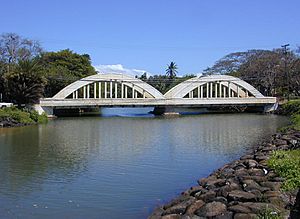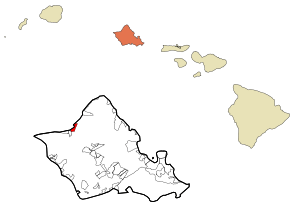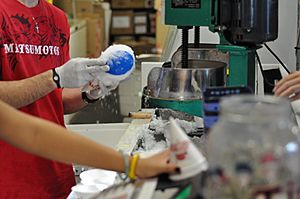Haleʻiwa, Hawaii facts for kids
Quick facts for kids
Haleiwa
Haleʻiwa
|
|
|---|---|

Historic twin-span "Anahulu Bridge" over the Anahulu River marks the north end entrance to old Haleʻiwa Town
|
|

Location in Honolulu County and the state of Hawaii
|
|
| Country | United States |
| State | Hawaii |
| County | Honolulu |
| Area | |
| • Total | 5.18 sq mi (13.41 km2) |
| • Land | 3.08 sq mi (7.97 km2) |
| • Water | 2.10 sq mi (5.44 km2) |
| Elevation | 12 ft (4 m) |
| Population
(2020)
|
|
| • Total | 4,941 |
| • Density | 1,605.26/sq mi (619.72/km2) |
| Time zone | UTC-10 (Hawaii-Aleutian) |
| ZIP code |
96712
|
| Area code(s) | 808 |
| FIPS code | 15-10750 |
| GNIS feature ID | 0358941 |
Haleʻiwa (pronounced hah-lay-EE-vah) is a lively community on the North Shore of Oʻahu island in Hawaii. It's known as a "census-designated place" (CDP), which is a special type of community defined by the U.S. Census Bureau. Haleʻiwa is part of the City and County of Honolulu.
This charming town sits on Waialua Bay, right where the Anahulu Stream (also called Anahulu River) meets the ocean. You'll find a small boat harbor here. The bay is surrounded by two beautiful beach parks: Haleʻiwa Beach Park to the north and Haleʻiwa Aliʻi Beach Park to the south.
Haleʻiwa is the biggest shopping and business area on Oahu's North Shore. It has kept its old-fashioned plantation town feel, which makes it a favorite spot for both locals and visitors. People come here to enjoy surfing, paddleboarding, and diving. In 2020, about 4,941 people lived in Haleʻiwa.
Contents
Exploring Haleʻiwa's Location
Haleʻiwa is located in a beautiful part of Oahu. It's found at coordinates 21°35'24" North and 158°6'50" West. The town stretches southwest along Kamehameha Highway (State Route 83).
How to Get Around Haleʻiwa
When you're in Haleʻiwa, Kamehameha Highway changes into State Route 99 at a large traffic circle often called "Weed Circle." This route then goes east across Oahu's central plateau towards Wahiawā. There's also a newer road, the Joseph P. Leong Highway, which helps drivers avoid the traffic circle and the main town.
The historic Rainbow Bridge crosses the Anahulu River and marks the start of old Haleʻiwa Town. This area is full of small shops, places to eat, and art galleries.
Haleʻiwa's Size and Water Features
The total area of Haleʻiwa is about 7.7 square kilometers (3.0 square miles). Most of this area, about 5.9 square kilometers (2.3 square miles), is land. The rest, about 1.8 square kilometers (0.7 square miles), is water. This means that about 23.67% of Haleʻiwa's total area is water.
A Look at Haleʻiwa's Past
Haleiwa has a rich history that dates back to the late 1800s. It started as a popular resort town.
The First Hotel and Railway
In 1898, a smart businessman named Benjamin Dillingham opened a hotel in the North Shore area. He named it Haleʻiwa. In the Hawaiian language, hale means "house," and ʻiwa refers to a type of bird called a frigatebird.
At the same time, Dillingham also built a railway line. This railway connected Honolulu to Waialua, running along the west coast. It ended right in front of his new hotel. The railroad even had a special passenger train called the Haleiwa Limited, which made the trip in just two hours. This railway company was known as the Oahu Railway and Land Company.
Protecting Haleʻiwa's Historic Charm
To keep its unique character, Haleʻiwa was named a State Historic, Cultural and Scenic District in 1984. This means that any new buildings must be designed to look like the older buildings from Haleʻiwa's sugar industry days. The town has 30 historic buildings that show off this special plantation style of architecture.
Haleʻiwa's Role in History
Haleʻiwa played a small but important role during World War II.
A Wartime Airfield
On December 7, 1941, during the Japanese attack on Pearl Harbor, two brave American pilots, George Welch and Kenneth M. Taylor, managed to get their P-40B fighter planes into the air. They took off from the Haleʻiwa Airfield, which is no longer in use today. Their quick actions helped defend against the attack.
Who Lives in Haleʻiwa?
The population of Haleʻiwa has changed over the years. In 2000, there were 2,225 people living there. By 2020, the population had grown to 4,941 people.
A Diverse Community
Haleʻiwa is a diverse place where people from many different backgrounds live. In 2000, the community included people who identified as White, Black or African American, Native American, Asian, Pacific Islander, and those of two or more races. A portion of the population also identified as Hispanic or Latino.
Families and Households
In 2000, there were 770 households in Haleʻiwa. About 28.8% of these households had children under 18 living with them. Many households were made up of married couples, while others were led by single parents or individuals living alone. The average household had about 2.88 people.
Learning in Haleʻiwa
The Hawaii State Department of Education manages the public schools in Hawaii. Haleʻiwa Elementary School is located right in the community. Another nearby school, Sunset Beach Elementary School, also has a Haleʻiwa address but is located in the Pupukea area.
Fun Things to Do in Haleʻiwa
Haleiwa is a fantastic place for fun and adventure, especially if you love the ocean!
Enjoying Shave Ice
One of the most famous spots in Haleʻiwa is Matsumoto's Shave Ice. This local favorite has been serving Oahu's most popular shave ice for over 50 years. It's open every day, so you can always grab a cool treat.
Beach Activities and Surfing
Haleʻiwa Beach Park offers many activities. You can take surfing lessons there all year round from schools like North Shore Oahu Surf School or Uncle Bryan's Sunset Suratt Surf School. The North Shore Surf Girls also offer lessons. The beach park is also close to shops, restaurants, and historic sites in Haleʻiwa Town.
Some beaches in Haleʻiwa are becoming popular for "foil surfing." This is a newer type of surfing that uses a special board with a hydrofoil underneath.
Paddleboarding and Big Waves
Haleiwa Harbor is a great place for stand-up paddleboarding. During the winter months, Haleʻiwa experiences very large waves. This makes it a popular destination for "surf tourism," where people visit just to watch or participate in surfing.
See also
 In Spanish: Haleiwa para niños
In Spanish: Haleiwa para niños




